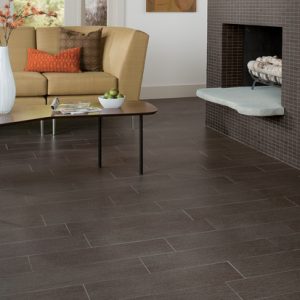Hardwood or Tile: The Advantages of Wood-Look Ceramic and Resilient Planks
 Looking at a plank of wood-look ceramic tile is disorienting. On top, it has a realistic wood grain stained onto its surface. It looks real. But when you turn it in profile, you can see that it is, in fact, a thick slab of glazed ceramic tile.
Looking at a plank of wood-look ceramic tile is disorienting. On top, it has a realistic wood grain stained onto its surface. It looks real. But when you turn it in profile, you can see that it is, in fact, a thick slab of glazed ceramic tile.
Why would you want ceramic flooring that mimics the look of wood? Why not just install wood?
Ceramic tile offers advantages that traditional hardwood just doesn’t have. Hardwood can contract in rooms that are exposed to a great deal of moisture, like bathrooms, basements or even some kitchens. Ceramic, on the other hand, has no such issues. Ceramic is also durable; you have less to worry about when you drop something on the floor.
As you may know, vinyl or resilient flooring also comes in a variety of looks that emulate wood planks. It offers big advantages in the softness department. Resilient planks (also called luxury vinyl planks) are warmer to the touch in cold months and also considerably less expensive than installing wood-look ceramic or porcelain tile. One of resilient’s biggest selling points is its durability. Whether you’re looking at commercial or residential flooring, this type of flooring can take a beating in even the most high traffic of areas and look great for the full 10 or 15 year life of the flooring. And, if damaged over time, the process to replace a few planks is quick and easy.
But even outside of the standard advantages of tile, wood-grain ceramic offers a unique look that makes a big impact. Once it’s laid down and grouted, no one is going to mistake your floor for real hardwood. But you’ll enjoy the warm, organic look of wood with a completely modern, updated spin.
Interested in learning more about this unique product and how it can fit into your home? Call Tish Flooring. We work with homeowners in Carmel and Indianapolis to stay on the leading edge of modern design and find styles that fit your life.

